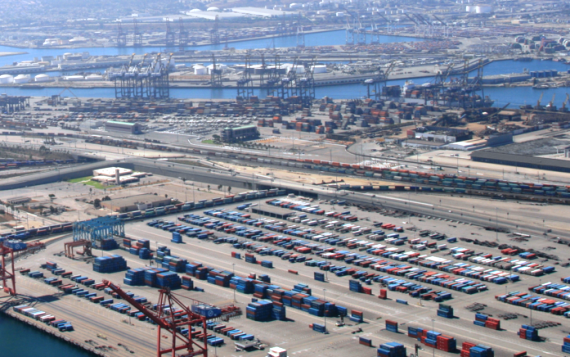-
These measures will enhance landside operations to help meet the unprecedented growth in cargo volume moving through the San Pedro Bay
-
Both ports will expand the hours during which trucks can pick up and return containers
-
The Long Beach port will take the first step towards a 24/7 supply chain by maximizing nighttime operations
-
The Los Angeles port will expand weekend operating gate hours to ensure that gate availability meets cargo demands
The ports of Long Beach and Los Angeles in the US have announced new measures to improve freight movement and reduce delays through the ports. This as the two busiest US gateways for trade with Asia continue to experience record volumes and see unprecedented numbers of cargo ships stuck at anchor off their coast.
These measures will enhance the ports’ landside operations to help meet the unprecedented growth in cargo volume moving through the San Pedro Bay, the ports said in a September 17 statement.
Specifically, both ports will expand the hours during which trucks can pick up and return containers, the ports’ statement said.
Mario Cordero, executive director of the Port of Long Beach, said this port will take the first step towards a 24/7 supply chain by maximizing nighttime operations.
Port of Los Angeles executive director Gene Seroka said the port will expand weekend operating gate hours on a pilot basis to ensure that gate availability meets cargo demands and provides greater transparency to improve efficiency.
In addition, both ports have called on marine terminal operators to incentivize the use of all available gate hours, especially night gates, to reduce congestion and maximize cargo throughput capacity.
Seroka said the measures are in response to the unprecedented global supply chain disruption being felt at the San Pedro Bay Port Complex.
“These steps, in addition to what has previously been recommended, demonstrate that the Port of Los Angeles will continue to innovate in order to manage this historic cargo surge,” he said.
“The Port of Long Beach is prepared to take bold and immediate action to help the supply chain move the record cargo volumes that keep our economy moving,” added Cordero.
The two ports will work closely with the trucking community to ensure that all truck operators understand how to take advantage of incentivized gate hours as well as the expanded opportunities that will be created to move cargo during non-peak times.
In addition to expanded hours and incentivized reservation priority, the ports urge terminals and the trucking community to consider other corrective measures.
More ships coming
The measures come as a record number of vessels are waiting to get into the two ports and more ships are expected to arrive to unload cargo for the holiday season.
At present, average ship waiting time is now 8.5 days, up from earlier reports of 7.6 days of waiting.
Seroka in a September 16 CNBC interview said the pileup is due to “the convergence of the pandemic-induced buying surge that we’ve been witnessing for over a year now with our traditional peak season year-end holidays [prompting] all the cargoes rushing to market as quickly as it can be moved through.”
This is even though productivity at the Los Angeles port is up 50% for each vessel call, he said.
“That also makes for loading and offloading of cargo at 11,000-plus container units the best in the business today,” said Seroka. “But we’ve got many nodes in the supply chain that have bottlenecks and we’ve got to start untangling them to make sure the products get to market.”
The Port of Los Angeles reported that even as more than 60 vessels were anchored outside the southern coast of California, another 20 ships were due to arrive. Trade volume is up 30.3% so far this calendar year.
With the pandemic still raging around the world, US consumers have not fully resumed previous spending on services, such as restaurants and travel, but continue to pour their money into buying goods.
Lars Jensen, CEO of container shipping consultancy service Vespucci Maritime, in a social media post said that as of September 17 he had counted 64 vessels waiting outside Los Angeles/Long Beach—up from 54 vessels at the beginning of the week.
This compares to a pileup of around 25 vessels in the beginning of the year, which at that time was already seen as a major disaster, he said.
Jensen pointed out that the ports of Los Angeles and Long Beach are not the only place with challenges, noting that 27 vessels were similarly piled up off the coastline from Savannah.
Ports are critical gateways to the US economy. Approximately 70% by tonnage of all US-international trade moves by water through the nation’s ports. The San Pedro Bay ports move approximately 40% of all containerized cargo entering the US each year and about 30% of all containerized exports.
The Port of Los Angeles and Port of Long Beach are the two largest ports in the nation, first and second respectively, and combined are the ninth largest port complex in the world.
Photo by John Murphy





